
views
Taking the Wheel off the Bicycle
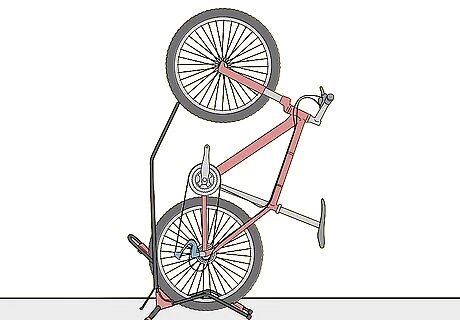
Use an upright bike stand to elevate the wheel while you work. If necessary, you can turn the bike upside down to work on it, just be sure to lay an old towel or cloth beneath the saddle and handlebars to prevent scratching them.
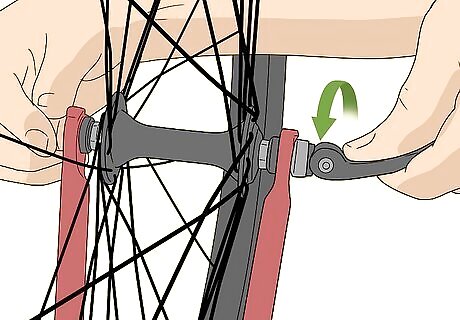
Loosen the nuts on the wheel axle with a wrench. Use silicone spray or even cooking spray if the nuts refuse to loosen with a wrench or ratchet alone. Some newer bikes have much simpler, quick-release wheel latches — in this case, just open the latch without removing the wheel yet.
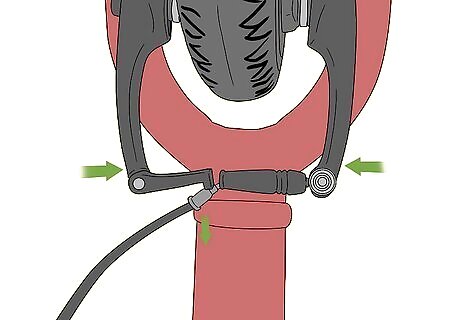
Disconnect the brakes if they're in the way of taking off the wheel. There are numerous types of brake mechanisms with different releases, but you'll often find a quick release on either the brake calipers or the hand brake lever. Or, you might need to squeeze the calipers on the brakes to disconnect the cable. Check your bike's instruction manual if you have it, or search the website of the bike or brake manufacturer.

Pull the chain out of the way if you're removing the back wheel. You can give the chain more slack by adjusting the gears. Shift until the chain is on the outermost gear on the rear wheel and the innermost gear on the pedal spindle. Pull back on the rear derailleur (which guides the chain during gear shifts) so that the chain pulls away from the cassette's (gear disc's) cogs.
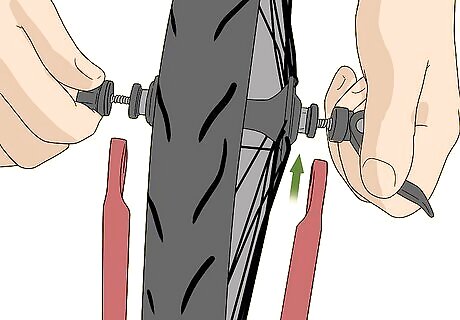
Slide the wheel free from the bike. You simply have to guide the front wheel's axle — now that the nuts or quick-release are loose — out of the forked slot that holds it to the frame. For the rear wheel, however, you need to more carefully guide the wheel down and forward (for an upright bike) past the chain and anything else in the way. Keep pulling back on the rear derailleur to move the chain clear of the wheel.
Taking out the Damaged Tube
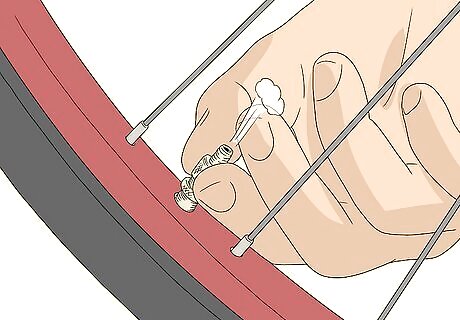
Let the rest of the air out of the tire. For a Presta valve, unscrew the valve stem's top part to release the air. With a Schrader (American) valve, use a thin tool (like an Allen wrench) to push on the plunger inside the threaded valve stem. For a Dunlop valve, pull on the valve tip after you loosen the cap a few turns. Schrader valves are the same ones used on car tires. Presta valves have a locknut on the end, and are longer and thinner than Schraders. Dunlop valves are thicker than Prestas but thinner than Schraders, and only have threads near the top. Some bike wheels use a lock ring to secure the valve stem to the bike rim. Unscrew and keep this lock ring if your wheel has one.
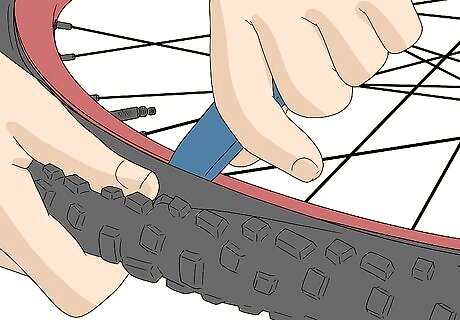
Use a tire lever to separate a section of the outer tire and wheel rim. You'll need a set of 2 plastic tire levers to complete the job — they're not expensive, and metal alternatives like spoons or screwdrivers can easily damage your wheel. Stick 1 lever between the outer tire and wheel rim, and pry out a section of tire. Now, instead of resting in a channel on the rim's inside, this section will be on the outside. Keep the tire lever wedged in place.

“Unzip” the remainder of the outer tire with the second tire lever. Stick the second tire lever next to the first one, in the gap between the rim and the section of tire that's outside the channel. Keep one of the levers in place and run the other all the way around the rim. The outer tire should pop out of the channel as you go, almost like you're unzipping a jacket.
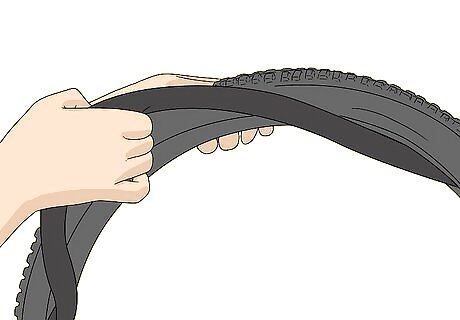
Reach into the gap between the tire and rim to pull out the tube. Separate the tire and rim until you can fit your hand into the opening and grab the rubber tube inside. Run your hand around the wheel and pull out the whole tube. Push the valve stem down through the rim when you get to it, then pull it out with the rest of the tube.
Patching or Replacing the Tube
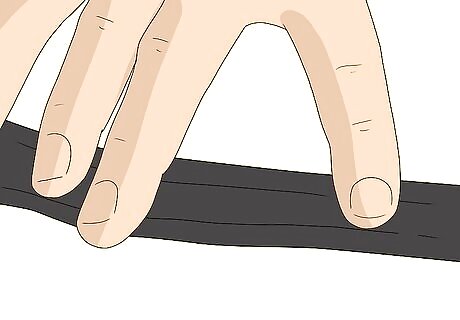
Check for sharp objects on the underside of the tire tread. Run your finger or a cloth around the entire channel in which the bike tube rests when installed. Be careful not to cut yourself, since you might come across a nail or shard of glass. Remove anything that might damage the tube you're about to repair or replace. While you're at it, inspect the tire for cuts or other damage. If you find a cut longer than ⁄4 inch (0.64 cm), replace the tire rather than trying to repair it.
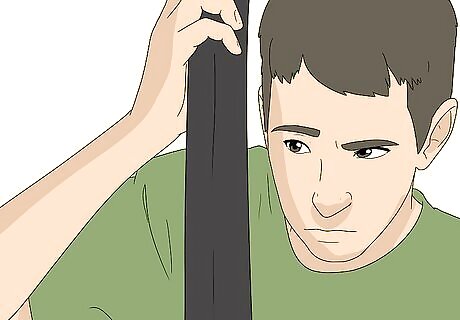
Add some air and use your ears and eyes to find the tube's puncture. Pump in enough air that the tube takes its circular shape, then hold it up to your ear one section at a time. If you can't hear the hissing from the leak, dunk the tube one section at a time into a bucket of water. Hold it still for several seconds each time. When you see air bubbles escaping from the tube, mark the puncture you've just found with a marker or tape. Even if you can see a puncture right away, it's smart to check for additional holes or tears.
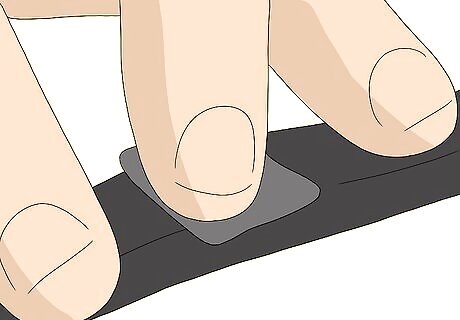
Sand and glue the damaged spot, then affix a repair kit patch. Bike tube repair kits are inexpensive, and easy and useful to have around. Rough up the area around the puncture with the included sandpaper. Then apply the glue as instructed in the kit. Press the patch onto the glue and hold it for as long as the kit directs. Peel the plastic cover from the top of the patch to complete the repair. Now your tube should be as good as new! If you've lost the kit's little piece of sandpaper, you can use a rough surface like the pavement or even your zipper to scuff the tube.

Replace the removed tube if it's too damaged to repair. There's really no limit to how many small punctures you can patch up so that you can reuse the tube. However, gaping holes or large tears are another matter. If the tube you've removed is visibly torn or shredded, just install a new tube in the same way you'd install a patched one. Replacement tubes are inexpensive and easy to carry in a bike pouch.
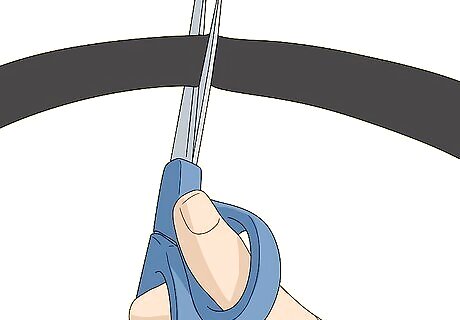
Cut and tie off the tube in an emergency situation. You should always carry a repair kit and at least one spare tube in a bike pouch, but all is not lost if you don't have either one. Simply cut the tube apart at the puncture, tie off each cut end with a knot, then tie the two knots together. The rubber bike tube should still be stretchy enough to fit over the wheel rim. Use this only as a temporary fix. This is not an ideal solution and should only be done if absolutely necessary. The tire may fail suddenly with this kind of repair, which could lead to serious injury.
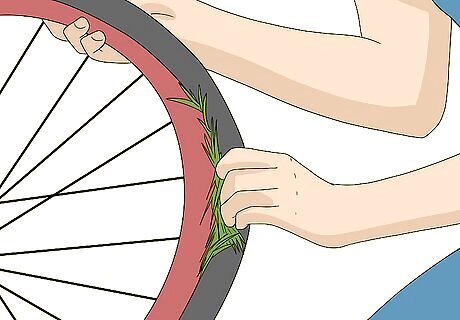
Make a short-term repair if you're out of other options. Start pulling up blades of grass if you lack a repair kit or replacement tube, and your damaged tube is completely shredded. Cram as many handfuls of the grass as you can between the outer tire and the wheel rim to create a semi-rigid cushion. But install a proper tube as soon as possible! Use caution when riding as your bike will not handle properly when you employ this kind of fix. Also, this type of fix may damage the rim.
Inserting the Tube and Attaching the Wheel
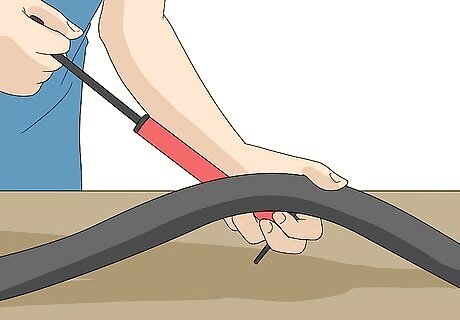
Add enough air to give the tube a basic circular shape. Filling it to roughly one-third to one-half of its final pressure is fine. This will make it easier to install the tube and less likely that it will get pinched between the outer tire and the wheel rim — which will cause a tear.
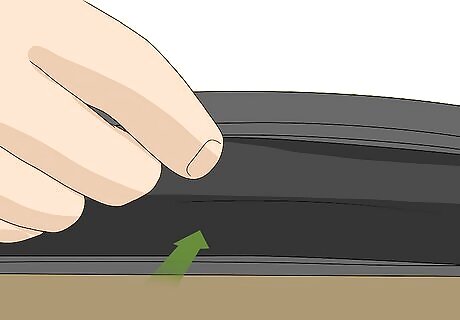
Separate the outer tire and wheel rim and push the tube in. Feed the valve stem through the hole in the rim to start the process, and secure it to the rim with the lock ring if it has one. Then carefully work your way around the wheel and push the tube into place. Check often to make sure the tube is not twisted or sticking out anywhere.

Pull and push the outer tire back into place on the wheel rim. After you've installed the tube, insert one section of the tire at a time — with your hands — back into the channel on the inside of the wheel rim. You may find it easier to tug on the tire with one hand while pushing with the other. You can use the tire levers if necessary, but you might end up puncturing the tube or scratching or bending the wheel with them.

Pump up the tube to its full recommended tire pressure. Find the recommended pressure in psi (pounds per square inch), bars, or kilopascals on the side of the outer tire. Check the pressure with a tire gauge, since an improperly inflated tire is more likely to get a hole or tear in it.

Put the wheel back on the bike. Reverse the process you used to remove the wheel from the bike: Slide the wheel onto the frame's fork, but avoid the chain or other obstructions. Reconnect the brakes, reversing the procedure you used to disconnect them — this will vary by brake type. Latch the quick release or tighten the nuts that hold the wheel in place. Hop on your bike and go for a spin!




















Comments
0 comment